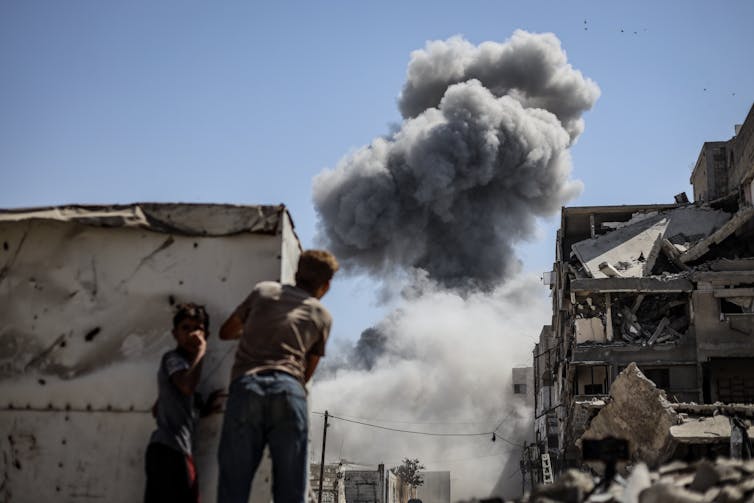
By Asher Kaufman
The latest U.S.-sponsored peace plan for the Middle East was unveiled at the White House on Sept. 29, 2025, and immediately accepted by Israeli Prime Minister Benjamin Netanyahu.
The proposal, which U.S. President Donald Trump said marked a “historic” moment that was “very close” to ending the two-year-old war in Gaza, will now go to Hamas. The Palestinian group said it was reviewing the document, having had it delivered by Egyptian and Qatari mediators.
Should it be accepted, hostilities would end “immediately,” according to the plan. But given that all previous U.S.-backed attempts have to date failed, there is reason for skepticism. The Conversation turned to Asher Kaufman, an expert on the modern Middle East and professor of peace studies at the University of Notre Dame, to explain what is different about this plan – and how it might fare.
What are the main points of the new plan?
The plan outlined by Trump in the presence of Netanyahu consists of 20 points.
If accepted by Israel and Hamas, it would see the full withdrawal of Israel Defense Forces from the Gaza Strip in three stages.
The first stage would be dependent on the release of the remaining 48 hostages taken during the Oct. 7, 2023, attack in Israel by Hamas and Palestinian Islamic Jihad, 20 of whom are believed to be alive. At the same time, Israel would release 250 Palestinians serving life in prison, as well as 1,700 Gazans arrested after Oct. 7.
This stage would also see humanitarian aid flow immediately to the desperate population in Gaza.
Stage two would see Gaza governed by a temporary transitional body consisting of a technocratic, apolitical committee composed of Palestinians and international members.
The committee would be overseen by a “board of peace” headed by Trump and other heads of state, including former U.K Prime Minister Tony Blair. This board would also oversee the reconstruction of the Gaza Strip and its economic development.
Hamas’ members would be given amnesty if they laid down their arms, but would also have to agree – along with other members of militant Palestinian factions – to not have any role in the governance of Gaza.
A new military body to be called the International Stabilization Force would be established and deployed in the Gaza Strip. The plan calls for it to be composed of Arab and international partners.
Only then would the Israeli military withdraw completely from Gaza, at which point the post-war Gaza plan would turn to economic redevelopment.
How does this differ from past US-backed plans?
The portions of the plan that include Israeli withdrawal, the release of hostages in exchange for Palestinian prisoners, and the provision of mass humanitarian aid to Gaza are similar to past agreements, including the last one that collapsed after Israel violated its terms in March 2025.
But there are new parts. These include the creation of the board of peace and the International Stabilization Force.
The former gives concrete structure to Trump’s older ideas to develop the Gaza Strip as a real estate venture; the latter provides a framework for an international military force that would police the strip for the foreseeable future.
The plan also mentions a long-term horizon for self-determination and the establishment of a Palestinian state – a point not raised in previous proposals, which mainly focused on ending the war in Gaza but neglected to include a longer-term pathway to statehood.
What would post-Gaza look like under this plan?
Trump sees the Gaza Strip as a real estate development opportunity – he has said as much in the past, and again talked on Sept. 29 of the opportunities of the coastline of Gaza.

Khames Alrefi/Anadolu via Getty Images
As such, his “vision of peace” is designed mainly through an economic-development lens.
The plan envisions a reconstructed strip supported principally by regional players that could stabilize the region and provide in the short term humanitarian relief and in the long term economic opportunities to Gazans.
The Trump administration and Israel hope to have not only a Hamas-free Gaza but a depoliticized Gazan population in its entirety.
With no role for Hamas, who will represent Palestinians in Gaza?
It is not clear from the plan who will represent Palestinians. But reading between the lines, one can see the possibility of a revamped version of the Palestinian Authority, the body that nominally governs parts of the West Bank, that could take the role of “Palestinian technocrats.” Point nine of the plan suggests that the Palestinian Authority could have a role in the future of Gaza after the Palestinian Authority “has completed its reform program,” but it does not say what this reform program entails.
The plan also suggests that Palestinian police forces would be trained and supervised by the International Stabilization Force and stationed in the Gaza Strip. That also hints to the possibility that the Palestinian Authority’s police – which has long been accused by Palestinians of working in concert with the Israelis to provide security in the West Bank – could take up this role.
Netanyahu has long resisted considering the Palestinian Authority as a viable body to govern Gaza in the “day after” the war.
So if this plan goes into effect, the question of who makes up the Palestinian technocratic administration might certainly be one of the main stumbling blocks.
What are the chances of the plan being accepted?
There are two main barriers.
In Israel, Netanyahu will need to get the approval of the far-right members of his government, who in the past have resisted anything short of a continuation of the war and the final takeover of the Gaza Strip by Israel. Netanyahu knows that his political future is dependent on keeping far-right members of his coalition on board – and that dynamic has undone past pushes for the end of the war.
For Hamas, if this agreement is realized, it would mean the end of its military and political presence in the Gaza Strip.
As such, the political and militant body – which has governed the territory since June 2007 – will need to be in a desperate situation to accept the terms. Or perhaps, Hamas may finally be attuned to the desperate plight of Gazans and respond to it.
The plan, as worded, gives them little to hold on to as an achievement after Hamas sparked two years of war on Oct. 7, 2023, with unbearable sacrifices for Palestinians.
It is not far-fetched to think that Netanyahu is supporting Trump’s plan knowing that chances of its realization are very slim. In the last two years, Netanyahu has demonstrated that he is mainly motivated by his own political survival and he will not take any step that would jeopardize it.
By accepting the plan, he demonstrates his alliance with the American president. It could also win Netanyahu valuable political capital in Israel: allowing him to present himself as willing to end the war, but safe in the knowledge that it will likely be rejected by Hamas.
Given the fact that the plan has no concrete timeline, particularly in relation to Israel’s staged withdrawal, it also buys him valuable political time. It could allow Netanyahu to place himself in a better position domestically, with national elections scheduled for October 2026. If Netanyahu sees that public opinion shifts in his favor he could even move forward with early elections, as he often did in the past, to capitalize on the moment.
![]()
Asher Kaufman Professor of History and Peace Studies at the University of Notre Dame.




























Bo Peep says
It will be peace until they surprise attack, abduct, murder and tape their neighbors again
PaulT says
Can the Israel government be trusted to keep the peace after the living hostages and the remains or those who died in captivity are returned? History suggests otherwise.
Joe D says
This deal sounds great…….IF:
Given the past history of EXTREMISTS in both Israel AND Hamas EXTREMISTS in Gaza, all its going to take is ONE SMALL GROUP on either side (or BOTH) who are not pleased to see a ceasefire and disarmament, to split with the agreement rules and initiate an incident (however small), which will TRIGGER the LARGER sides of the conflict to blow the peace process out of the water, and extend this conflict even longer than it has been.
The current Israeli Prime minister was not particularly well supported inside Israel PRIOR to the HAMAS attack, due to his attempts in taking over the court system, making them all answerable to Him! Once the HAMAS attack occurred, all the prior Israeli national protests against him and opposition suddenly rallied behind the Prime Minister, including suspending Israeli National elections, which prior to the Hamas attack, there was no guarantee he would have won.
So here we are….all HOPING this ceasefire holds for the sake of Israel/Palestine/ and the rest of the world! Enough lives have been destroyed on either side!
Kennan says
Dubious as I was, my suspicions as to how this so called”peace deal”would go have all come to fruition.
Trump does a victory lap as 20 Israeli are freed. 2,000 Palestinian civilians are freed. As all of this transpiring Israeli soldiers continue to violate ceasefire, as they bomb and set fire to homes in Gaza city.
Benjamin Netanyahu has never wanted a two state solution. A two state solution would only slow down the”Greater Israel” agenda. The fact that Netanyahu agreed to release 2000 Palestinians in exchange for 20 Israeli hostages, was proof to me that unsurprisingly there were several
“Back room”deals. Deals that would satisfy both Benjamin Netanyahu, as well as the most TRANSACTIONAL NARCISSIST to ever lead our country. What those deals are exactly are not known, but they will be. They won’t be good for Palestinians. Israel is a state and Palestine WAS a country. Palestinians were never treated like neighbors, they were just OCCUPIED.
Palestinians will never have a chance at
“Self determination”. Conquest through immigration is what we have seen from the forced exodus of 3/4 of a million Palestinians during the NAKBA of 48, to the Occupation in 1967, and the subsequent control and Apartheid suppression of Palestinians decade after decade. Imagine what that does to you.
Trump was beating his chest at the Knesset for what will be a very one sided peace deal, all the while acknowledging Miriam Adelson and her 100,000,000 dollars in bribe money to become a CUCK to Israel as we annex the West Bank.
Americas leaders have a price and as long as Israel controls the politisphere, Then Palestinians and any chance of self-determination will blow through and away like a sandstorm.
What a Hamas did on October 7, 2023 was a war crime by any rubric, but it doesn’t justify or come close to the vicinity of what Israel has done, in what is now a 21st century holocaust that has been live streamed all over the world.
Money is king and greed is real. How are Palestinians to ever get a fair shake when 80% of Congress is bought and paid for by the American Israeli political action committee as well as so many other Israeli lobbies. Hundreds of millions of dollars. Literally.
I feel like everybody is on the take. I wish I were wrong about any of this, but I fear I am not.